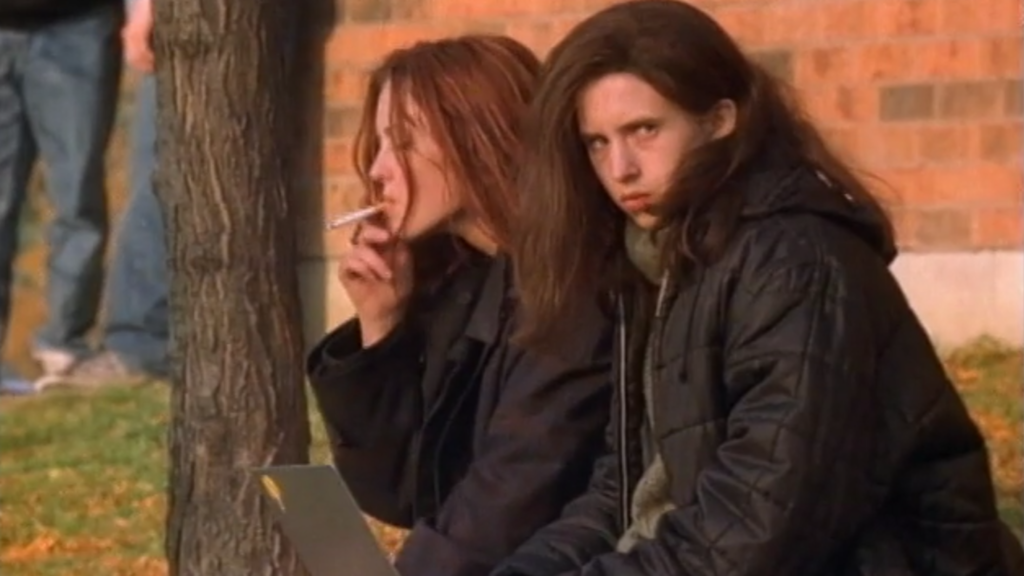Ginger Snaps
2000

Rated: NR
Genre: Horror
Country: Canada
Run-Time: 1h 48min
Director: John Fawcett
Cast
Emily Perkins……………….Brigitte Fitzgerald
Katharine Isabelle………Ginger Fitzgerald
Kris Lemche………………….Sam
Mimi Rogers………………….Pamela Fitzgerald
I’ve always put off watching Ginger Snaps. I know it gets mentioned a lot, but the combination of teens and werewolves just never looked appealing to me.
But one thing I learned by completing my Top Ten Modern Horrors of 1999 video is that some good horror movies can be easily overlooked due to personal biases.
So I’ve started changing the way I do things. Don’t get me wrong, I am always going to hop around to different years and horror subgenres as opportunities present themself. But I’m also going to start placing more emphasis on a single year in order to force myself to watch the films I might have pushed aside otherwise.
(So yeah, I’m probably going to work on the Top Ten Modern Horrors of 2000 next. And you can expect Ginger Snaps to be somewhere on it.)
I now realize that I should have never put off watching Ginger Snaps for as long as I did. (Especially since we are both Canadian.) Ginger Snaps is a film that has a lot more going on than teens and werewolves. It also makes clever use of horror as a metaphor, includes some astute social commentary and approaches the coming-of-age tale in a rather unique way. I know a lot of people like to push the feminist angle when discussing this film, but honestly, feminist or not, this is just really, really good storytelling.
Directed by John Fawcett- who is best known as the creator of the television show Orphan Black– Ginger Snaps is a story that centers around two teen sisters, Ginger (Katharine Isabelle) and Brigitte (Emily Perkins). Over time, the sisters have developed a codependent relationship centered around common interests, including a fascination with death. In fact, the two sisters have made a suicide pact to leave the suburb by sixteen or die together- a pact that is intentionally difficult for viewers to determine just how serious the girls are about it.
Needless to say, the sisters’ morbid fascinations, which includes some pretty impressive photographs of staged death sequences, has alienated them at school. Of course it’s possible the sisters only turned dark and intentionally standoffish because they were already ostracized. Who knows? What is clear is that over time they have intentionally put up barriers between themselves and their peers and this has led to clashes, particularly with other girls. Some hormonal boys, on the other hand, have begun to take notice of the older Ginger’s inherent beauty.
As the film opens, we learn that the suburb the girls live in has a minor crisis. Several local dogs have been slaughtered by what is assumed to be a wild animal nicknamed “The Beast of Bailey Downs” and people are being warned to stay in at night until the animal is found.
Unfortunately, when the sisters are out one night to enact a revenge plot against a girl bully, Ginger has her first period and the scent attracts unwanted attention from “The Beast”- which turns out to be a werewolf-like creature. The girls survive the attack, after the creature is hit by a van, but not before Ginger is bitten.
If you haven’t already figured it out, the lycanthropy-menstruation metaphor is going to be heavily leaned on in the first two acts of Ginger Snaps and it works so well you wonder how nobody had ever made the connection before. Connecting lycanthropy to puberty…sure…that’s what Teen Wolf does. But the gender flip makes additional sense because of the monthly cyclical pattern.
But honestly, if the menstruation metaphor was the only thing Ginger Snaps had going for it, I wouldn’t have liked it as much as I did. Fortunately, the film is also ripe with increasingly relevant social commentary in a world that is now seeing parents getting arrested for the violent acts of their children.
Which comes back to that suicide pact that both is and isn’t a real thing. After all, Ginger is sixteen and she hasn’t killed herself yet. But her fascination with morbidity hints at possible neuroses. After all, the whole reason she got bitten was because she was out at night attempting to enact a plan to kidnap the dog of a girl she doesn’t like. Whether or not she would have gone through with the plan is unknown, but it seems more certain as the movie progresses is that Ginger might never have fully ruled out the pact as a real thing even though the younger sister, Brigitte, seems to have.
And these blurred lines make Ginger a fascinating character. As her transition gets more monstrous and her actions become more monstrous, the question must be asked: is Ginger worth saving? And that is a question that keeps coming back to Brigitte- but it also plays out in an interesting subplot with their mother. Like Macbeth and the witches. Was Macbeth a budding psychopath and the witches just upped the timeline? Or did the witches actually corrupt him? Now substitute witches with werewolves and you see just how great the writing in this film really is. There is an almost Shakespearian level tragedy at play that can be reinterpreted based on how we fill the unknown about the sister’s history.
Like I said, Ginger Snaps is more than just teens and werewolves. Ginger Snaps is about the potential psychopath in the family and the lengths loved ones are willing to take to ignore the signs or cover up potential problems.
Ginger Snaps is also a film that works because of the way Isabelle and Perkins play off of each other as similar, and yet very different, sisters. Sure, little sister Briggitte acts a bit too much like a live-action Daria, but I always liked Daria as a character so I’m not about to complain. But she’s not just in this film to be dowie- this film is really her coming-of-age story, even if she isn’t the one directly playing out the menstruation werewolf metaphor. (Perkins, whose stated age in the film is fifteen, was actually around twenty-three when Ginger Snaps filmed. Fun fact: she played the original Beverly from the 1990 TV mini-series It.)
In contrast, Isabelle’s character oozes with increasing self-aware erotic energy. The challenges that Ginger’s symbolically sudden sexual awareness and ravenous appetite takes on the sister’s relationship is the pulse of the film and makes it relatable to any set of sisters close in age. (Isabelle, who was only nineteen when Ginger Snaps filmed, ended up being a serious scream queen. She even plays the title character in American Mary.)
And though I give John Fawcett a lot of credit here for his directing, some interviews I’ve read suggest the true MVP might actually be co-writer Karen Walton. Fawcett supposedly encouraged her to write the horror film she wanted to see and the most subversive parts and intelligent parts of Ginger Snaps were mostly the result of that effort.
Ginger Snaps was a winner the moment the script was printed. Thankfully, Fawcett had the know-how to bring it to life.
